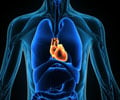A new study reveals that abnormal development of heart cells during embryogenesis may be responsible for the underdevelopment of inner walls in the heart

Vidu Garg, MD, the study's lead author, previously reported that a single nucleotide change in the GATA4 gene in humans causes atrial and ventricular septal defects along with pulmonary valve stenosis. In mice, the GATA4 gene has been shown to be necessary for normal heart development and its deletion leads to abnormal heart development.
"While GATA4 has been shown to be important for several critical processes during early heart formation, the mechanism for the heart malformations found in humans with the mutation we previously reported is not well understood," said Dr. Garg, a pediatric cardiologist in The Heart Center and principal investigator in the Center for Cardiovascular and Pulmonary Research at The Research Institute at Nationwide Children's Hospital.
To better characterize the mutation, Dr. Garg and colleagues generated a mouse model harboring the same human disease-causing mutation. They saw heart abnormalities in the mice that were consistent with those seen in humans with GATA4 mutations. Upon further examination, they found that the mutant protein leads to functional deficits in the ability for heart cells to increase in number during embryonic development.
"Our findings suggest that cardiomyocyte proliferation deficits could be a mechanism for the septal defects seen in this mouse model and may contribute to septal defects in humans with mutations in GATA4," said Dr. Garg, also a faculty member at The Ohio State University College of Medicine. "This mouse model will be valuable in studying how septation and heart valve defects arise and serve as a useful tool to study the impact of environmental factors on GATA4 functions during heart development."
Advertisement














